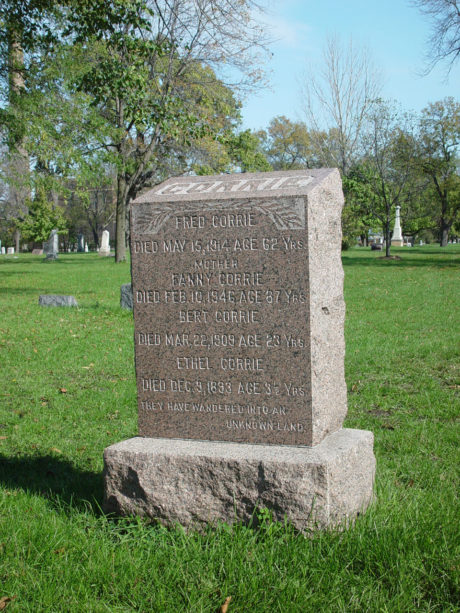Tales from Pioneers and Soldiers Cemetery
By SUE HUNTER WEIR

The inscription carved on the Corrie family’s marker undoubtedly referred to life after death, but it also accurately captured the lived experiences of thousands of people buried in Minneapolis Pioneers and Soldiers Cemetery. They are the ones who traveled thousands of miles to establish new homes in Minneapolis. Once settled, they tended not to travel far. They may have moved from house to house but for the most part they rarely strayed far from their first neighborhood—near to jobs, churches, family members and friends.
The Corrie family came to Minneapolis from England by way of Canada. Frederick Charles Corrie, the patriarch, was born in 1852. When he was 30 years old, he moved with his wife, Frances (Fannie) Hill, and their oldest son, also named Frederick, to Quebec. Two more children, Herbert and Tenice Rose, were born there. In 1889, they made one more major move—this time to Minneapolis. After traveling more than 4,000 miles, they were finally home.
Fanny gave birth to three more children. In 1890, she had twin girls, Edith and Ethel, and in 1892, she gave birth to Ralph. Ethel died from pneumonia in 1893. In 1909, Herbert, known as Bert, died from appendicitis at the age of 24 and was buried next to his little sister..
Frederick Sr. found work as a plumber and in 1896 bought a home at 2825 East Lake Street. The area was relatively undeveloped at the time but a little less than ten years later one of the city’s major attractions, Wonderland Park, was built two blocks east of their home. Wonderland was just that—a wonder that attracted thousands of visitors every weekend—but it was regarded as a nuisance by many of the families who lived nearby.
In 1905, Frederick Corrie Sr. gave a deposition in a lawsuit that pitted the congregation of Elim Presbyterian Church, located at 32nd Avenue and Lake Street, against the owners of Wonderland Amusement Park. Elim’s members sued to keep the park closed on Sundays. They were in the right—the park was in violation of a law dating back to Minnesota’s territorial days that prohibited nonessential businesses from opening on the Sabbath. The law was enforced erratically, but still on the books. Although Frederick Corrie did not attend the church, he weighed in on the congregation’s side:
“The Wonderland show makes a great deal of noise both in day time and night time and gathers a very noisy crowd to its grounds, particularly on Sunday…I can distinctly hear the great noise from the Wonderland grounds in my house with all of the doors and windows shut. The scenic railway, the merry-go-round, the band, and the miniature railway all make a great deal of noise as well as the outcries of the people on the grounds so I can hear all of them in my house with the doors and windows shut tight.”
Although he didn’t mention them in his deposition, fireworks at the park’s eleven o’clock closing time, every Tuesday and Friday night, very likely kept many of the neighborhood’s early-to-rise, blue-collar workers up at night.
The park’s management company offered to move the church several blocks down the street but the church’s pastor refused as a matter of principle. In his eyes, the park would still be violating the Fourth Commandment. A trial date was set but postponed for several months and something clearly changed in the interim, though what it was is a mystery. Some type of settlement must have been reached since the congregation, though not the church building, did move and Wonderland stayed open on Sundays.
The Corries remained in their home for several more years. The elder Frederick C. Corrie died from bladder cancer on May 15, 1914. Fanny outlived her husband by 32 years. She was one of about 85 people who met the criteria to be buried in the cemetery after it was closed to future burials in 1919. She died on February 10, 1946, from bronchial pneumonia, at the age of 85. She had given birth to six children in three different countries. She is buried in the family’s plot, Lot 90, Block N. Frederick J. Corrie, the couple’s oldest son died in 1961; on his death certificate his father’s name was listed as Frederick I, perhaps a tip of the hat to the family’s British roots. He is buried in Oak Hill Cemetery.









